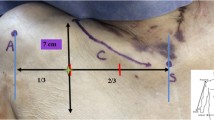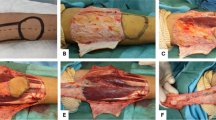Summary
The major ruptures of the rotators cuff point out the problem of their surgical repair. Various techniques are described in the literature, among them the deltoid flap technique, described by Apoil and Augereau. This technique points out the problem of a few cases of flap early necrosis (Saragaglia). We studied the deltoid arterial blood supply on 40 cadaveric shoulder, after coloured injection into the subclavian artery. Our study included 40 macroscopic and 15 radiographic observations. The thoracoacromial artery gave off two collaterals to the anterior part of the deltoid muscle. The first one, called the deltoid artery, ran into the anterior part of the deltoid, near the deltopectoral line. In 53%, it gave off a first superior collateral branch, which ran at 3 cm under the clavicle. The second one, called the acromial artery, ran deep to the anterior part of the deltoid muscle, near the clavicle and the acromion. The posterior circumflex humeral artery was the most important artery. It supplied the posterior and middle parts of the deltoid muscle. The anterior circumflex humeral artery supplied the anterior part of the deltoid muscle in 63%. In ten cases, we dissected a deltoid flap. In all the cases, the acromial artery was cut near the acromion. When the deltoid artery gives off its superior collateral branch, it was always cut. Then, this flap was only vascularized by its inferior aspect. These results show that the flap is located in a poorly supplied area. Thus, the flap necrosis could be explained by an insufficient anastomotic network. An operative technique modification could avoid this complication.
Résumé
Les ruptures de la coiffe des rotateurs de l'épaule présentant une vaste perte de substance tendineuse posent le problème de leur réparation chirurgicale. Plusieurs techniques ont été décrites dans la littérature pour leur réparation, dont la technique du lambeau deltoïdien (Apoil et Augereau). Dans notre expérience et celle de Saragaglia, cette technique peut se compliquer de nécrose aseptique précoce du lambeau dans quelques cas. Nous avons étudié la vascularisation artérielle du m. deltoïde sur 40 épaules de sujets non embaumés, après injection colorée de l'a. subclavière. Notre étude a comporté pour chaque épaule une observation macroscopique après dissection et une étude radiographique dans 15 cas. Nos résultats montrent que le lambeau deltoïdien est prélevé dans une zone de transition vasculaire. Nous pouvons diviser le lambeau en trois régions vasculaires correspondant aux trois pédicules artériels: aa. thoraco-acromiale, circonflexes humérales antérieure et postérieure. La préparation du lambeau s'accompagne obligatoirement de la section des collatérales de l'a. thoracoacromiale. La vascularisation du lambeau se trouve ainsi fragilisée. Sa nécrose pourrait s'expliquer par un réseau anastomotique défaillant et par la tension donnée lors de la suture à la coiffe restante. Une modification de la technique opératoire est à l'étude.
Similar content being viewed by others
References
Apoil A, Augereau B (1985) Réparation par lambeau deltoïdien des grandes pertes de substance de la coiffe des rotateurs de l'épaule. Chirurgie 111: 287–290
Apoil A, Augereau B (1988) Réparation par lambeau deltoidien des grandes pertes de substance de la coiffe des rotateurs de l'épaule. Rev Chir Orthop 74: 298–301
Augereau B (1990) Réparation des coiffes incontinentes par lambeau de deltoide. Chirurgie 116: 190–193
Breda M (1954) Vascularisation et innervation fasciculaire du muscle deltoide. C R Ass Anat, 41 ème réunion, 1047–1053
Determe D, Rongieres M, Kany J, Glasson JM, Bellumore Y, Mansat M, Becue J (1996) Anatomic study of the tendinous rotator cuff of the shoulder. Surg Radiol Anat 18: 195–200
Le Double (1897) Variations du système musculaire de l'homme. Reinwald, Paris, pp 1–10
Poirier J, Charp A (1911) Traité d'Anatomie humaine. Masson, Paris, pp 316–325
Reid CD, Taylor GI (1984) The vascular territory of the acromio-thoracic axis. Br J Plastic Surg 37: 194–212
Rockwood, Matsen (1990) The shoulder. WB Saunders, Philadelphie, pp 57–59
Rouviere A, Delmas A (1984) Anatomie humaine. Masson, Paris, pp 218–223
Salmon M, Dor J (1933) Les artères des muscles des membres et du tronc. Masson, Paris, pp 7–13
Salmon M (1939) Les voies anastomotiques artérielles des membres. Masson, Paris, pp 99–103
Saragaglia (1989) Le conflit sous-acromiocoracoïdien. J Chir 126: 591–595
Testut L, Latarjet A (1948) Traité d'Anatomie humaine. Doin, Paris, pp 285–296
Winninger AL (1971) Les artères musculaires du deltoide. Anat Anz 129: 489–492
Author information
Authors and Affiliations
Rights and permissions
About this article
Cite this article
Hue, E., Gagey, O., Mestdagh, H. et al. The blood supply of the deltoid muscle application to the deltoid flap technique. Surg Radiol Anat 20, 161–165 (1998). https://doi.org/10.1007/BF01628888
Received:
Accepted:
Issue Date:
DOI: https://doi.org/10.1007/BF01628888




